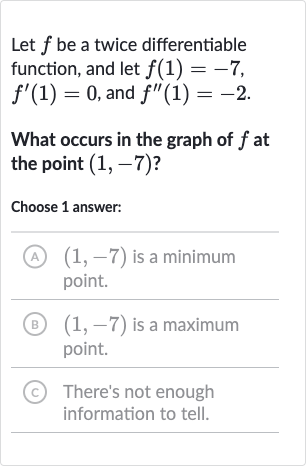Full solution
Q. Let be a twice differentiable function, and let , , and .What occurs in the graph of at the point ?Choose answer:(A) is a minimum point.(B) is a maximum point.(C) There's not enough information to tell.
- Analyze Function's Derivatives: To determine the nature of the point on the graph of the function , we need to analyze the given information about the function's first and second derivatives at the point .
- First Derivative at : The first derivative of the function at is given as . This indicates that the slope of the tangent to the graph of at is zero, which means the graph has a horizontal tangent line at this point. This could be indicative of a local maximum, local minimum, or a point of inflection.
- Second Derivative at : The second derivative of the function at is given as . Since the second derivative is negative, it tells us that the graph of is concave down at . This implies that the point is a local maximum.
- Conclusion: Given the information that and , we can conclude that the point is a local maximum point on the graph of the function .
More problems from Nth roots
QuestionGet tutor help
QuestionGet tutor help
QuestionGet tutor help
QuestionGet tutor help
QuestionGet tutor help
QuestionGet tutor help

